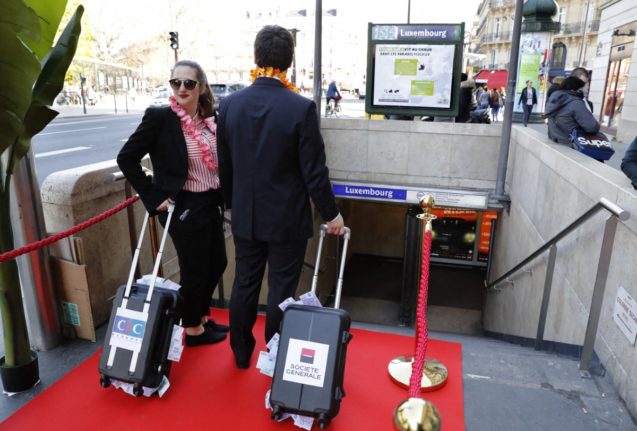Paris is a city where the majority of residents don’t own a car, so it’s far from unusual to see people take items like pieces of furniture, plants, Christmas trees or DIY equipment onto the Metro, tram or bus.
Likewise as a popular tourist destination it’s far from unusual to see people with big rucksacks or outsize suitcases.
But what do the rules actually say about taking outsize items onto public transport with you?
First, Paris public transport operator RATP stipulates that you must be able to manage and carry the item yourself, and that you must keep it with you at all times.
Paris is a city that has repeatedly been struck by terrorism, so transport operators have to take abandoned luggage reports seriously – a single lost or abandoned bag can lead to the closure of a whole Metro line while it is investigated. On behalf of all Paris commuters – please do not be this person.
Luggage
Any type of suitcase, bag or rucksack is allowed onto the Metro, RER and the Montmartre funicular, but each piece must be less than 75cm long/wide. There is no weight limit and no limit to how many pieces of luggage each traveller is allowed – although you do need to be able to manage all your bags yourself – including taking them up/down stairs.
On the bus and tram there is no specific size limit, “as long as you do not hinder other passengers on the bus”.
If the carriage or bus is crowded, it is considered good manners to carry a rucksack by hand or wear it on your front, so you are not smacking your fellow passengers in the face every time you turn around. Allowing your wheeled suitcase to run over a fellow passenger’s foot is unlikely to make you any friends.
Strollers/buggies or prams
Strollers or buggies are allowed – RATP stipulates ‘preferably folded’ but this is not obligatory and plenty of people leave them assembled, especially if the child is asleep. On the bus or tram, unfolded buggies are allowed at the driver’s discretion.
Be aware that most Metro stations require you to go up or down stairs to access the platform, only a tiny percentage of stations have an elevator. Contrary to their somewhat grumpy reputation, most Parisians are actually happy to help you to carry a stroller up or down stairs if you are struggling.
Furniture/ DIY equipment/ plants/ other random stuff
It’s not hugely unusual to see someone get onto the Metro toting something a little bizarre – from a 6ft tall plant in a pot to a dining chair or an armful of wood for a DIY project. The simple explanation being that most Parisians don’t own a car and taking the Metro is often the simplest way to get bulky items home.
As above, RATP stipulates that you must be able to manage the item yourself, but there is also a size limit.
Items can be “no more than 2 m long, but measuring no more than 20 cm in other dimensions, provided you hold them vertically”.
The size limit applies to the Metro, RER and Montmartre funicular, while on the bus or tram there is no specific size limit, as long as it does not inconvenience fellow passengers.
Musical instruments and skis
Skis are allowed – because although they are long they are less than 20cm in other dimensions – provided you carry them vertically. Paris itself doesn’t have much of a ski scene (being mostly flat and not very cols) but during the winter it’s not that unusual to see fellow passengers toting skis and an overnight bag as they head off to the mountains for a weekend.
Musical instruments are generally allowed provided they meet the size criteria – but cannot be played on board. Metro operators give licences to a certain number of buskers per year (via a competitive audition process) but they are not permitted to play on either the platform or the train itself. That doesn’t stop unlicensed buskers playing on the trains, but they are breaking the rules and will be fined if caught.
Bikes/scooters
Bikes are not allowed on the Metro, bus, tram or Montmartre funicular.
You can take a bike on RER lines A, B, C, D and E, but only during the following hours:
- All day long Saturdays, Sundays and bank holidays,
- Before 6.30 am, between 9am and 4:30pm and after 7pm on all other days.
Roller skates, skateboards, scooters are banned on the entire public transport network, although it’s not that unusual to see people trying to take an electric scooter (trotinette) onto the Metro. In some particularly egregious cases they eve ride the scooter down the platform, earning undying hatred from their fellow passengers.
Pets
On the bus and tram dogs are only allowed if they are small (weigh less than 6kg) and are carried in a basket or carrier. Cats are also allowed if they are in a carrier.
On the Metro and RER bigger dogs are also allowed, provided that they are on a lead and muzzled.
Guide dogs and other assistance dogs are allowed on all public transport, but if stopped by an RATP agent you may need to show a disability card or other proof that you have a disability and the dog is an assistance animal.
Other rules
The Paris public transport network has a few other unexpected rules, including a ban on praying.
READ ALSO: All the things you can be fined for on the Paris Metro



 Please whitelist us to continue reading.
Please whitelist us to continue reading.
Member comments